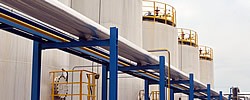The world currently consumes approximately 3 million tons per year of synthetic and semi-synthetic finished lubricants, but the rate of usage varies significantly between regions and countries, said consultancy Kline & Co.
The Parsippany, N.J.-based consultancy Kline shared some of the findings from its report, “Global Synthetic Lubricant Base stocks: Market Analysis and Opportunities,” in a May 20 webinar.
The Asia-Pacific region held 44 percent of the world’s 39.9 million tons of finished lubricants (including process oils) demand in 2014. North America followed at 23 percent and Europe at 17 percent. Grouped together, Africa and the Middle East accounted for 8 percent, and South America held 8 percent, too.
The key distinction between regions is in the quality of lubricants. In Asia, said Project Manager Anuj Kumar, lubricant quality varies greatly between different countries –from markets that accept the lowest tiers of products, to top-tier markets such as Japan, South Korea and Australia.
However, with many of the region’s national economies booming, Asia-Pacific is set to leap-frog some other regions to become one of the most pivotal markets for high-quality finished lubricants – and thus synthetic and semi-synthetic base stocks – in the coming years, Kumar said.
In contrast, the North American market is mature in terms of the quality of lubricants it consumes, Kumar said. It has a greater penetration of high-quality, low-viscosity lubricants than any other part of the world except Europe. Both markets increasingly call for synthetic or semi-synthetic base stocks.
The European finished lubricants market is also diverse. “On one hand, some countries in Western Europe are characterized by the world’s most stringent environmental regulatory laws that are pushing for lower vehicle emissions and better fuel economy,” Kumar continued. “On the other hand, eastern European countries consume a higher percentage of low- to mid- performance lubricants.”
South America and Africa and the Middle East mostly consume low- to medium-quality products.
Globally, synthetic and semi-synthetic lubricants account for about 14 percent of total demand. Europe has the highest penetration of lubricants derived from synthetic or semi-synthetic base stocks, reflecting the high level of performance of the finished products it consumes.
“In individual product categories, metalworking fluids in the industrial segment and PCMOs in the automotive segment have very high synthetic and semi-synthetic penetration,” he said.
“Synthetic and semi-synthetic base stocks are usually offered to provide superior performance at a higher cost, but superior performance means different things in different product segments,” Kumar continued. For PCMOs, it means moving toward lower and lower viscosity grades.
“With a large portion of Japanese cars in the North America and European markets, Japanese original equipment manufacturers are now trending toward lower viscosity grades in factory fill and even service fill recommendations. Base stocks used for lubricants meetings these standards need to meet these viscosity grades while providing low volatility and high oxidation and thermal stability. This is beyond the capability of API Group I and II stocks and requires usage of Group III or polyalphaolefin base stocks, at least as a correction fluid, if not as a main blending component.
“For the lightest grades of motor oils – 0W-20 or 0W-16 – the share of Group III or PAO is practically 100 percent and the product is by default a synthetic,” he added.
Synthetics have penetrated the heavy-duty motor oil market much slower for several reasons, Kumar noted. “At present, Group II suffices for most of the technical requirements for HDMO. Compatibility with ultra-low sulfur diesel, biodiesel, and emission control devices are addressed by additive additions rather than base stocks. Although it might change in the future, the HDMO market has not been a significant driver of synthetic base stocks growth.”
Kline estimates that the total demand for synthetic base stocks used for finished lubricants was just less than 3 million tons globally for the year 2014. Group III base stocks account for more than half of the synthetic base stocks market, as it is the preferred base stock for blending PCMOs. Group III is followed distantly by PAOs and synthetic esters, then polyalkylene glycols, polyisobutylene, phosphate esters, synthetic esters, alkylated aromatics.
While Group III and PAOs are heavily skewed toward automotive applications, the other types of synthetic feedstocks find their way more easily into industrial products.
Kumar noted a key driver for growth of synthetic lubricants throughout the world, and particularly in Asia-Pacific, is marketers’ ability to promote the products and clearly advertise their benefits.
- Products
-

- We are committed to the Lubrication and functional chemicals. Not only the better chemicals, we are also able to offer the high quality technology solutions.
- « Read more

